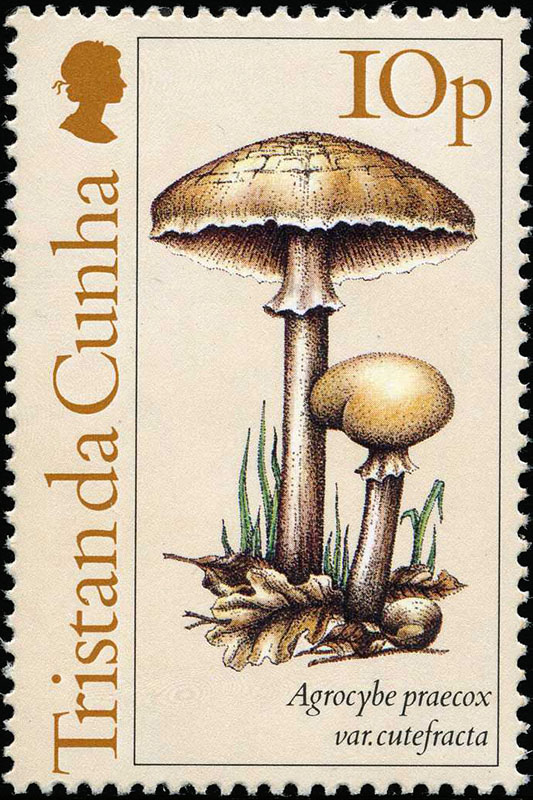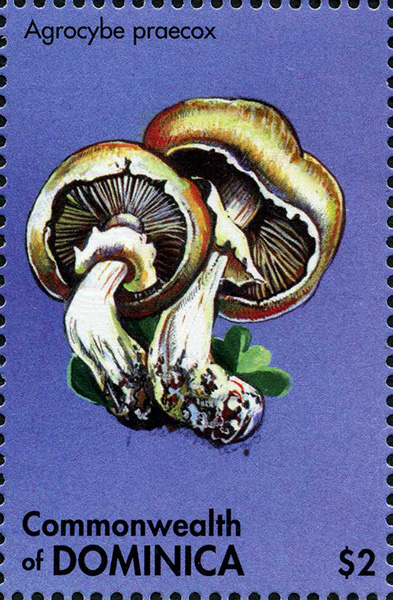Agrocybe praecox (Pers.) Fayod, 1889

(Da: www.funghiitaliani.it)
Phylum: Fungi Linnaeus, 1753
Classe: Agaricomycetes Doweld, 2001
Ordine: Agaricales Underw., 1899
Famiglia: Strophariaceae Singer & Sm. A.H., 1946
Genere: Agrocybe Fayod, 1889
Specie e sottospecie
Hypholoma fasciculare (velenoso) - Hypholoma sublateritium (velenoso) - Kuehneromyces mutabilis (buon commestibile).
Descrizione
Cappello da convesso a piano, cuticola opaca, viscida e di colore giallo scuro, sia da chiuso che da aperto. Lamelle quasi spaziate, sottili, di colore biancastro, tendono a ingiallire. Gambo ingrossato in un insieme di altri esemplari, bianco e striolato. Anello bianco, si colora di bruno a causa delle spore sovrastanti. Carne bianca-ghiaccio, immutabile. Odore: gradevole. Sapore: gradevole ma non da tutti apprezzato. Spore marroni in massa. Commestibile, però amaro e di resa piuttosto scarsa. Se ne sconsiglia il consumo per probabilità di scambio con specie velenose, talvolta anche con qualche pericolosa Inocybe.
Diffusione
Cresce gregario in gruppi composti da numerosi soggetti, raramente isolato, in primavera, da aprile a maggio, in pianura e fino alla media montagna. Basidioma terricolo, predilige l'ambiente boschivo, ma si può trovare anche tra l'erba di parchi e giardini. Non commestibile per il sapore amarognolo e per la scarsa carne del cappello. Somiglianze e varietà: Agrocybe praecox può essere confusa con Agrocybe molesta (Lasch) Singer, che le è molto simile ma più robusta, ha sovente la superficie pileica screpolata, sapore nettamente amaro e cresce nell'erba. Agrocybe vervacti (Fr. : Fr.) Singer di colorazione più giallastra, è priva di anello, ha la base del gambo dilatata e sapore dolce. Marasmius oreades (Bolton : Fr.) Fr. si differenzia per il gambo privo di anello, il colore bianco-crema delle lamelle che si presentano più distanti e più panciute e il sapore della carne buono, di nocciola. (Testo da: www.funghiitaliani.it).
Sinonimi
Agaricus togularis Bull. : Fr. 1793 = Agaricus praecox Pers. : Fr. 1800 = Agaricus gibberosus Fr. 1838 = Pholiota praecox (Pers. : Fr.) P. Kumm. 1871 = Agrocybe gibberosa (Fr.) Fayod 1889 = Hylophila togularis (Bull. : Fr.) Quél. 1894.
Bibliografia
–Marcel Bon (1987). The Mushrooms and Toadstools of Britain and North-Western Europe. Hodder & Stoughton. P. 262.
–Courtecuisse, R.; Duhem, B. (1994). Guide des champignons de France et d'Europe. Delachaux et Niestlé. P. 360.
–Henning Knudsen; Jan Vesterhout (2008). Funga Nordica. Copenhagen: Nordsvamp. P. 828.. Here A. praecox is admitted to be a complex of species including A. acericola and A. sphaleromorpha.
–See Meinhard Moser (1983). Keys to Agarics and Boleti. Translated by Simon Plant. 15a Eccleston Square, London: Roger Phillips. P. 290.
–For instance, search Species Fungorum with genus name = "Agrocybe" to find the related species. A. praecox is here.
–Timothy Flynn; O. K. Miller (1990). "Biosystematics of Agrocybe molesta and sibling species allied to Agrocybe praecox in North America and Europe". Mycological Research. 94 (8): 1103-1110.
–Kuo, M. (2006, September). Agrocybe praecox. See the MushroomExpert.Com article.
–See this "Champignons du Québec" page (in French) for a key incorporating the same relationships.
–Kuo, M. (2006, September). Agrocybe acericola. See the MushroomExpert.Com article.
–This page of Species Fungorum shows synonyms of A. praecox.
–See the Global Biodiversity Information Facility map, which provides hyperlinks to records with geographical location.
–See the Armorance web site (in French) on the natural history of Brittany.
–See the First Nature site.
–Phillips, Roger (2010). Mushrooms and Other Fungi of North America. Buffalo, NY: Firefly Books. P. 226.

|
Data: 26/03/1984
Emissione: Funghi Stato: Tristan da Cunha |
|---|

|
Data: 18/06/2001
Emissione: Funghi Stato: Commonwealth of Dominica |
|---|